You wouldn’t think puddles would offer much interest. But, there is a lot going on. As well as a mesh of vehicle tracks, there is an old car seat and wooden board, mountain bike tyre patterns, footprints of horse, dog and people and wildlife.
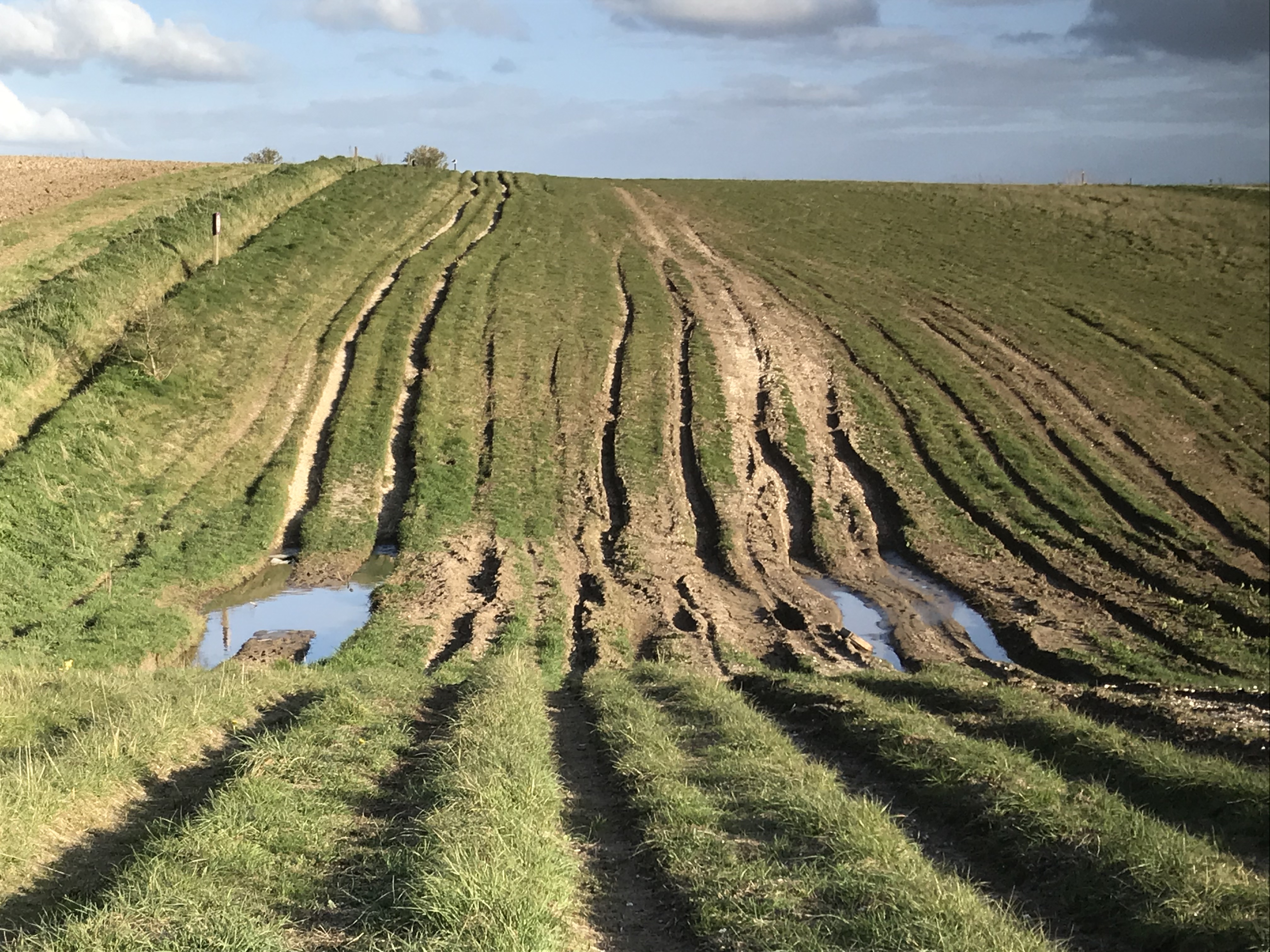
Larger and smaller puddles in dip along ridge with vehicle tracks
Over 10 visits sitting quietly in the late afternoons or early dusk with the sun going down slowly to the west, I watch various small brown birds drink or enthusiastically bathe with butterflies and bumble-bees sassying around against a backdrop of arable ploughing, the low ‘mrurr’ of cattle and ewes with bleating lambs. As discussed in an early Post, I’m trying to improve my identification of birds including their songs and calls. There have been a few successes in identifying small brown birds with much to learn.
On a larger scale, the larger puddles tend to collect in the dips between the undulating ridge line. At a finer scale, these puddles are a complex miniature landscape of ridges, ruts and flatter plateauxs with mini cliffs or shallow edges and variations in vegetation and damp-dry geometric soil patterns.
- Patterns in the soft mud
- Puddle mud shapes
- Footprints

The smaller puddles – one dried up early April with water remaining in the other for 2 weeks. Water returned to both after rain late April but disappeared with a few days of sunshine and wind
These subtly or more obviously change between visits depending on the mix of rain , sun and wind. In early April, there is water in all the ruts. At each visit, there is a descernible difference as to the extent of water compared to damp or drier soil in the smaller ruts, with much less fluctuation and always water present in the larger puddle.
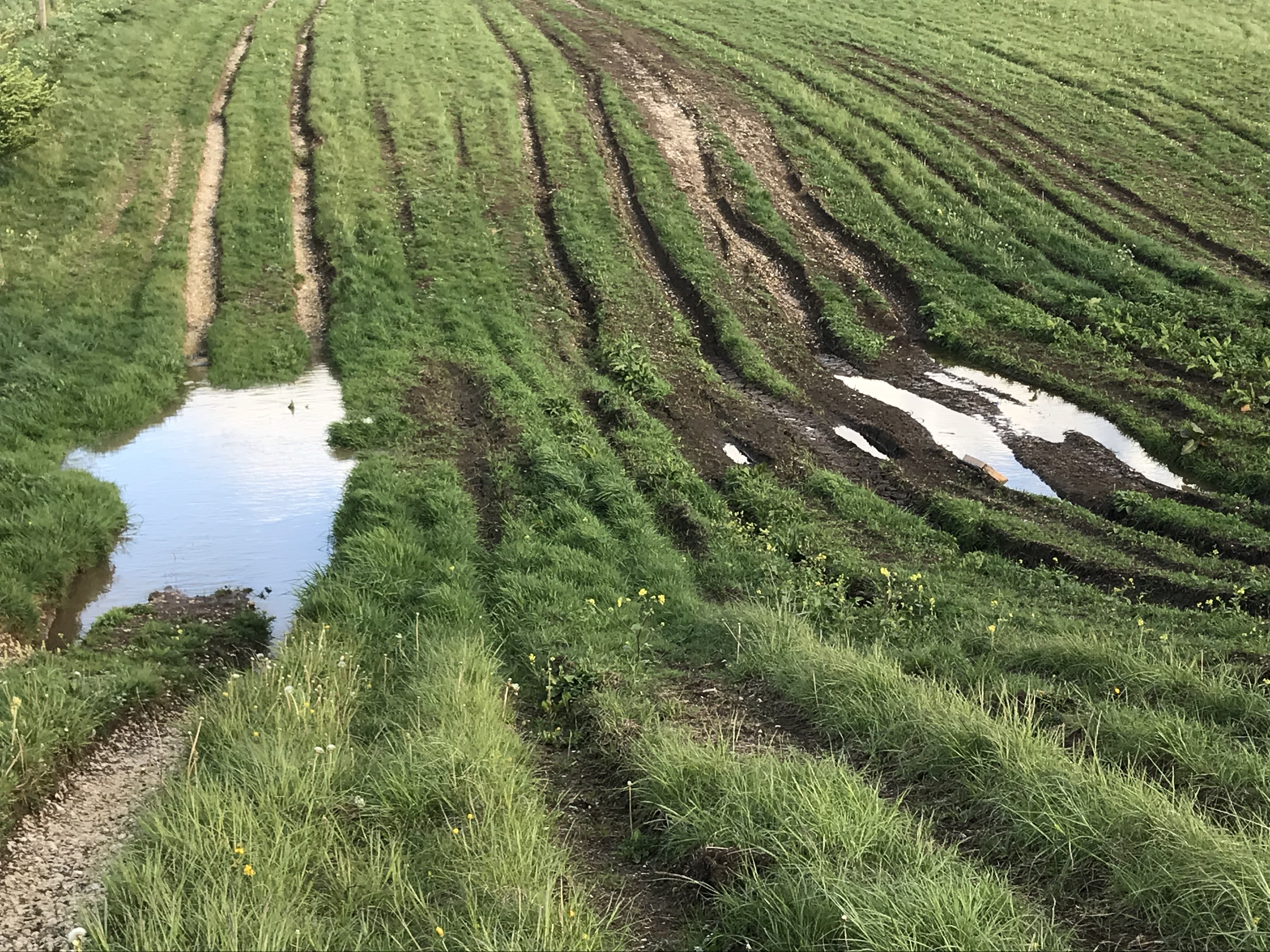
After rain late April
Early on, some dandelions began to flower and young umbellifer leaves tightly curled which by late April are fluffy seed heads, white lace flowers and cowslips in full glory.

Cowslips by late April
At the large puddle, there are almost constant series of small to larger rings on the water made by small insects touching down and some at least seem to die and form a black speckled graveyard. A dragonfly zips back and forth often hidden from my view by the small rise in the track with occasional peacock and brimstone butterflies fluttering around.
The brown birds are, as the books say, sparrow – starling size and brownish with browny white speckles. Due to high natural predation, they need to produce 2-3 broods per season. As with botany, I find relative characteristics such as size and colour difficult when similar objects are not next to each other. I realise the need for closer observation even with binoculars, so experiment with different places to sit. As time progresses, I do begin to see differences, such as in chunkiness, posture and beaks. It would help if the bird would stop very near me, pose, show helpful body angles like a model on a catwalk and carry a name placard!
Most early evenings have been gloriously sunny with a light breeze but I need a fleece in early April to accommodate the cooling. As I walk along, there’s distinctly chilled air for a few yards in the shallow dips along the ridge, giving a good localised illustration of a temperature inversion associated with high pressure systems. On other visits earlier in the day, the kit is T shirt and shorts with sun hat, sun cream and water. When sitting quietly, tucked into the lee of the track undulations, the ground area temperatures must be about 27 degree C. There seems a lull in bird activity both in song and visits to the puddle in the heat of the mid afternoons compared to later on.
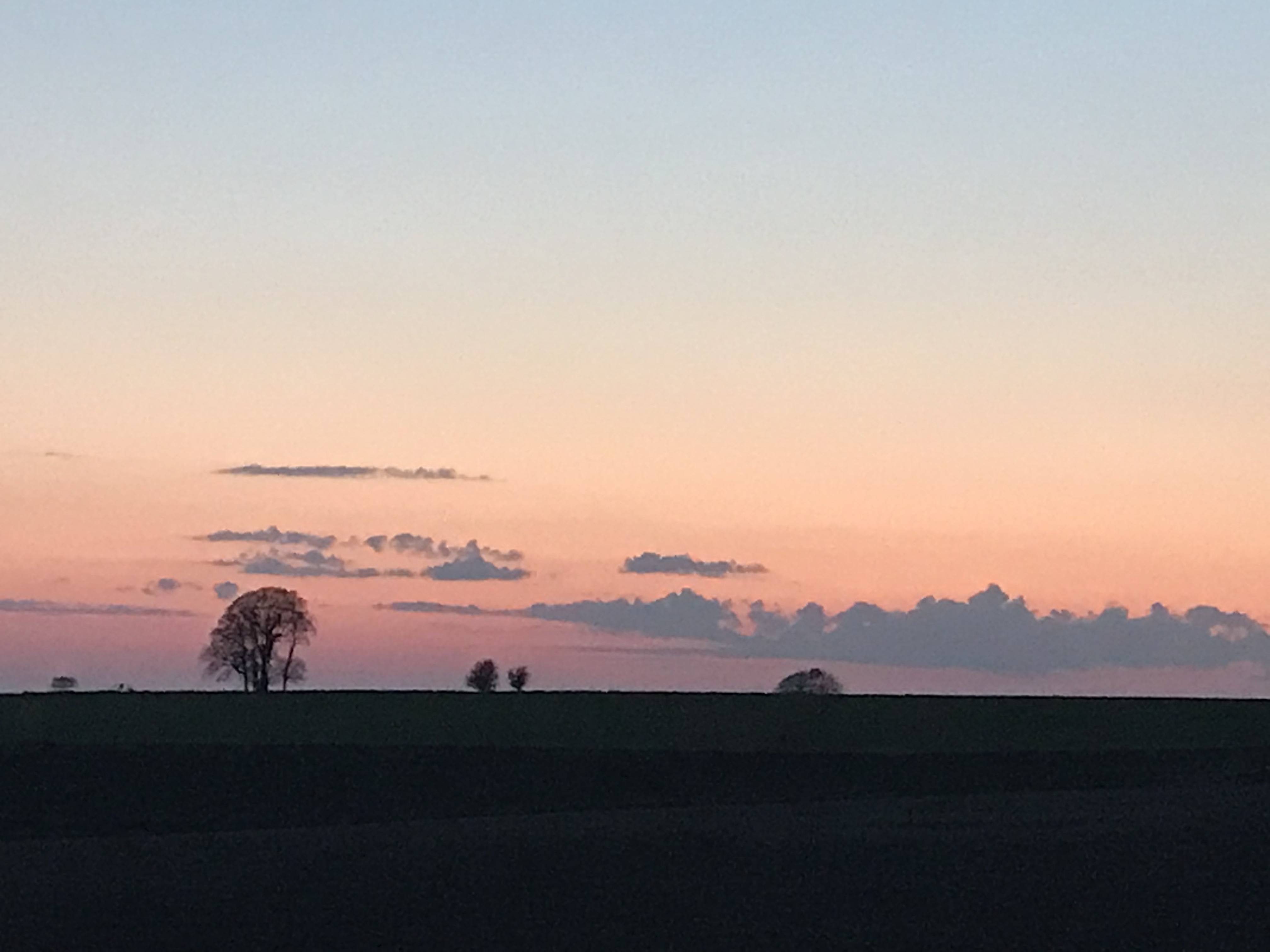
Sunset along ridge and grasslands
Nearer dusk, there’s been a full sun to west and 180 degrees to the east, a delicately outlined almost full moon which develops and rises into the sky as I walk back down the hill.
Skylark By the puddle, there’s a backdrop overhead of singing skylarks with their gentle parachute like descents which speed up nearer the ground. These are the males, which ascend vertically to hold station above their breeding territory. (Photo by DAVID ILIFF. License: CC BY-SA 3.0″). I seek out the small fluttering, hovering speck high in the air to trace the originator of the opera. On a couple of occasions, I’ve carefully followed the bird to its landing site to possibly be lucky in finding a nest – but too well camouflaged for a quick look before moving away.
I seek out the small fluttering, hovering speck high in the air to trace the originator of the opera. On a couple of occasions, I’ve carefully followed the bird to its landing site to possibly be lucky in finding a nest – but too well camouflaged for a quick look before moving away.
I’ve always found the long lasting, melodious song evocative of the uplands from my Dartmoor and Cheviot Hill rambles to Southern England heaths and farmland. The vicar – naturalist W Keble Martin describes a camping trip on Dartmoor to Aune head in 1914 just before the war began “The dew was very heavy. In the midsummer midnight twilight we watched foxes hunting with dripping wet coats…Before sunrise the sky became filled with skylarks singing singing their prime: then they all came down and fed hurriedly on caterpillars, and as the sun broke the horizaon, they all went up again and stayed up singing lustily. There were many and seemed utterly happy” (P67). Perhaps the skylarks I’ve listened to on the way to the Avon headwaters are the descendents.
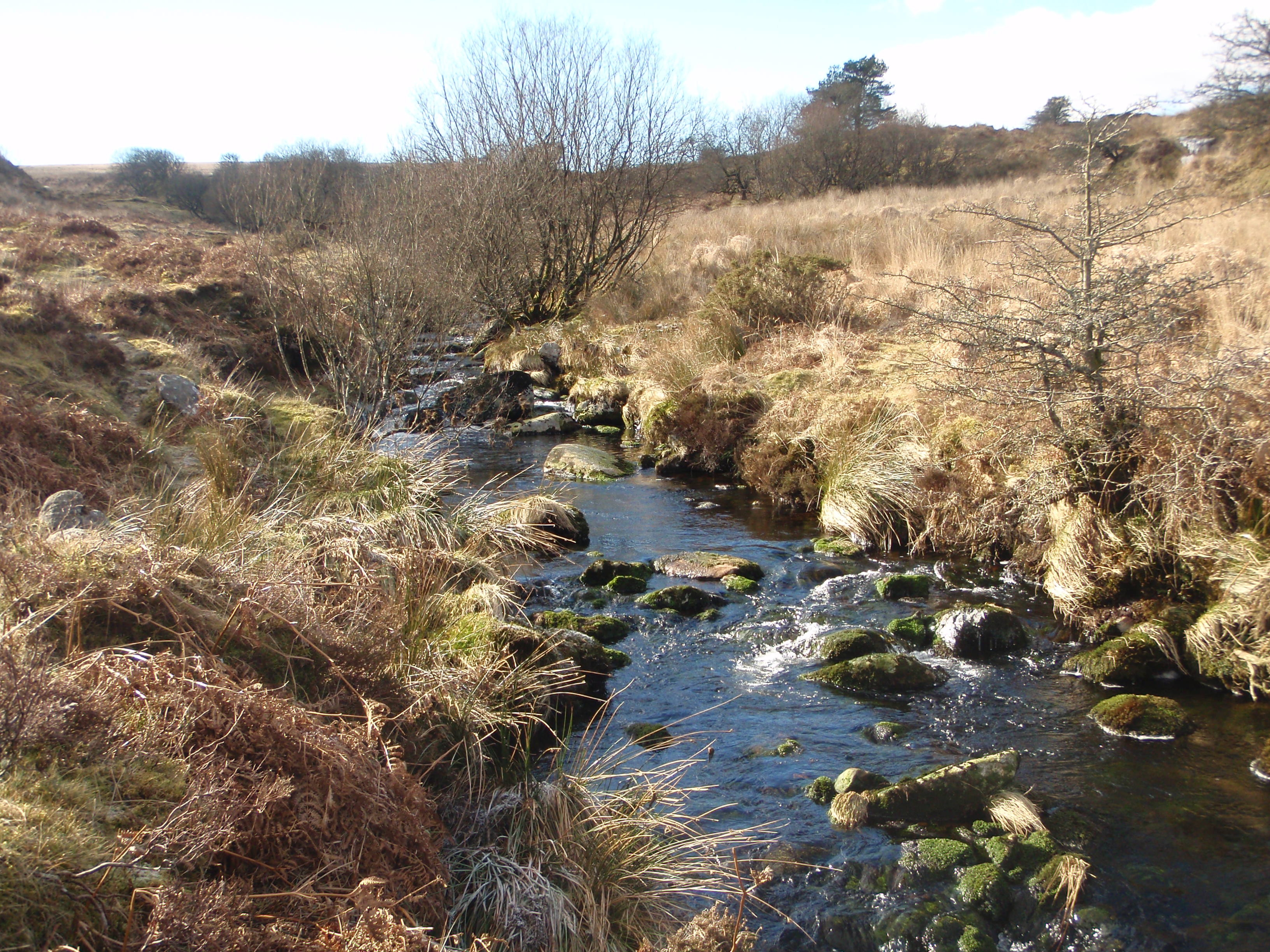
Heading towards Aune Head along the O Brook
Meadow Pipit At different times, I watch one -six meadow pipits in strutting or semi crouch stance around the puddle edges and always on the alert. They peck the ground and move between the dried vegetation stalks at the large puddle edge to visit the water. Sometimes, they just hesitantly sip looking up and around between each drink, but on 3 occasions it has been a full wash and brush up with head in, feathers and tail flicked and lets get splashing!
The bird hops out to shake and preen feathers on both sides of the body. As well as ‘a ‘brown bird’ like the skylark, I can get confused over song. One audio guide suggests thinking of the bird shouting out and accelerating its name ‘mip mip mip‘ or ‘seep seep‘ as it rises and I pick out the distinctive’ tseut tseut‘ as it parchutes back down with a trill towards the end. I’m confident on some occasions these are meadow pipits at the puddle, as on their departure flight they call ‘sweet sweet sweet’. ( Anne Burgess https://commons.wikimedia.org/wiki/File:Meadow_Pipit_(Anthus_pratensis)_-_geograph.org.uk_-_13413
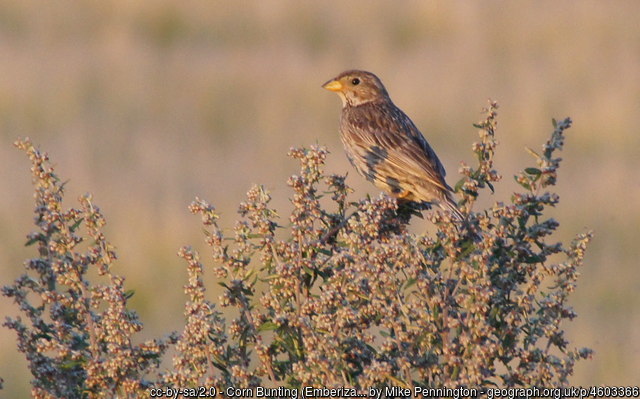
Corn bunting On close observation I can see corn buntings are chunkier with a thicker bill. They too like a good wash. The puddle reminds me of a hair salon with lots of comings and goings followed by calmer interludes. I like corn buntings for their distinctive song of jangling key rings. I see and listen to several of them in small flocks as I walk up to and along the ridge. (Photo Mike Pennington)
Other birds using the puddles Amongst these small brown birds comes welcome relief in identification with a male chaffinch and yellow hammers. There are two pairs at times, with the male having more and brighter yellow than the female, including on his head and reddy brown on the lower back. One bird as it hops between the dry earth clods is more upright and alert with the top of the head ruffled – by the wind ? 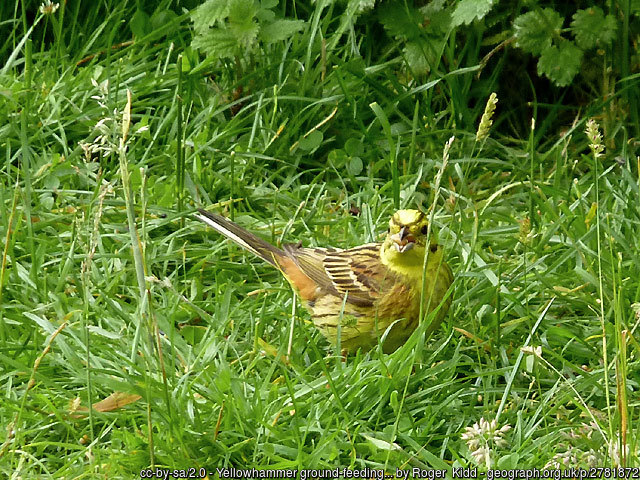 This song is also distinctive if monotonous during the breeding season as the classic ‘ little-bit-of -bread-and-cheese’. Sometimes, I hear just the ‘cheese‘. In amongst these browns and yellows, comes a pair of pied wagtails with a jerky bobbing gait and short runs across the ground and a distinctive song sounding like the ‘chiswick fly-over‘. And it does!
This song is also distinctive if monotonous during the breeding season as the classic ‘ little-bit-of -bread-and-cheese’. Sometimes, I hear just the ‘cheese‘. In amongst these browns and yellows, comes a pair of pied wagtails with a jerky bobbing gait and short runs across the ground and a distinctive song sounding like the ‘chiswick fly-over‘. And it does!
There are about 10 smallish hawthorn bushes and an occasional apple within about 50m of the puddle which are very popular with all these birds as they flit between these perches and the ground. They also move onto the adjacent recently ploughed arable to feed, where they are very well camouflaged against the variations of browns in the soil.

One of the occasional hawthorn small trees used a lot as perches by the ground nesting birds

Ploughed soil patterns and well used by birds
This provides an opportunity to watch other behaviour as well as to link calls and birds such as the ‘zit or trilip‘ of the yellow hammer and the abrupt ‘quit‘ call from a corn bunting. On one bush the five corn buntings and two yellow hammers perch to look the same way, into the sun over the puddle. The birds in this tree on different occasions always shifted to such orientation. I wondered if it was to do with wind direction but in other nearby bushes the birds were at different angles.
There are occasional overhead raptors. A yellowhammer by the puddle suddenly departs as it senses the male kestrel or windhover sooner than me. I’m distracted by a racket of cawing and mewing and watch two crows hassle a buzzard in a stand-off on the ground and in the air.
Nearby track On the return, I stop to watch a pair of wheeling lapwings over a newly ploughed field. I don’t know if they have a nest there. The bare, rough ground and a spring crop can be beneficial habitats. I always feel the peewit call sounds like a lament.

Bramble bush & common whitethroat
I’m chuffed to identify another small brownish bird singing from a low dense bramble bush as common whitethroat. I sometimes see the bird singing its scratchy song with gusto from the top of a branch before scuttling off into the lower tussocky grasses to give a grating churring warning call.
On the opposite track is a lonesome wind sculpted hawthon and I’m delighted to see a pair of ‘white ass’ or wheatears. They descend onto the ploughed field where their nest may be in a rabbit burrow. I used to help organise the repair of sheep stells of folds in Northern England and gaps would be purposefully left between stones as wheatear nest ‘holes’.
Cultural Associations These birds as part of the British bird fauna have been part of literature, music and art since earliest times. On browsing detailed chapters in The Shell Bird Book J Fisher 1973, I found gems such as learning about the madrigals by 16thC Orlando Gibbons and found the sublime ‘Silver Swan’. Numerous other composers have been inspired by bird song with some catching the natural rhythms such as George F Handel in the 18thC where bird song provided a pastoral background to his arias and Vaughan Williams in the early 20th C capturing the essence of a skylark in The Lark Ascending. The latter is accompanying this blog.
I also learnt about a Welsh bard of the 14thC, Dafydd ap Gwilym, who wrote of the “lark and the thrush as acolytes in the nightingales church in woods of song in cassocks covered with flowers..” and the 14thC Juliana Berners a Prioress in Hertfordshire who wrote treatises on hawking, hunting and fishing including The Boke of St Albans 1486 which are some of the earliest extant writings of their kind and include comments on environmental conservation and field sport etiquette. Medieval and Renaissance scholars / poets such as Geoffrey Chaucer, John Ray and William Turner had a detailed ornithological eye leading into the 16thC Age of Print and Science. John Clare the 19th C poet was a fine self taught field naturalist with an acute ear and eye as evident in The Skylark Poem. I have this as part of a Book by Carry Ackroyd’s paintings and prints ‘Nature Power and Spells‘
The rolls and harrows lie at rest beside
The battered road; and spreading far and wide
Above the russet clods, the corn is seen
Sprouting its spiry points of tender green….
Up from their hurry, see, the skylark flies,
And o’er her half-formed nest, with happy wings
Winnows the air, till in the cloud she sings,
Then hangs a dust-spot in the sunny skies,
And drops, and drops, till in her nest she lies,
Which they unheeded passed – not dreaming then
That birds which flew so high would drop agen
To nests upon the ground, which anything
May come at to destroy…..
As Food There are down to earth descriptions of birds as food and as a valuable commodity. The 17thC poet John Taylor describes how tasty wheatears are to eat and their seasonal movement (now known as migration) (From Shell Book p185)
“There were rare birds I never saw before, The Like of them I think to see no more: Th’are called wheat-ears, less than lark or sparrow, Well roasted, in the mouth they taste like marrow. When once ’tis in the teeth it is dissolv’d. The name of wheat-ears, on them is ycleped Because they come when wheat is yearly reaped, Six weeks, or thereabouts, then are catch’d there. And are well nigh eleven months, God knows where.
W.H Hudson in Nature in Downland 1934, talks about the annual harvest of wheatears or ortolans and skylarks, often for trade with the growing south coast towns. He recounts the wheatear was formerly a source of considerable profit to the shepherds. They knew that days with moving cloud and sun were the most profitable, as the birds sought a hole shelter every time a sudden shadow occurred presaging a hawk and so went into the traps ..the shepherds made their coops in July as a T shaped trench about 14 inches long …a horsehair spring to catch the bird by he neck as it passed in..” He gives an account from a shepherd in 1797:”…to supplement wages of £6 per year I caught great numbers during the season for taking them, which lasted from the middle of July to end of August. The most I ever caught in a day was thirteen dozen. We sold them to a poulterer at Brighton, who took all we could catch at eighteen pence a dozen……
Hudson reports that lark eating is common and widespread in Britain in the early 20thC and W. Keble Martin wrote of an encounter in 1900 when a family tutor at Henley on Thames. Another tutor who was a member of the British Ornithologists Union and keen on bird protection was given on his first evening dinner, lark pie “ with legs sticking out through the pastry, It was special and for his welcome” (p50)
Migration More recent behavioural insights are coming from studies on genetics and feather analysis to reveal where in the world an individual bird has moulted and micro geolocator tracking data as to migration routes. For example, there are currently 4 accepted sub species of Northern wheatear with two seen in Britain; one race breeds in the UK and the Greenland race continues north to the Arctic tundra. Both over-winter in tropical Africa comprising a 15,000-29,000 mile annual round trip. I fondly recall working with an ornithologist on the North York Moors who was monitoring observations of the Greenland race. (Extract Bird Life International + Daily Mail 15/2/2012 + http://safari-ecology.blogspot.com/2012/02/wheatears-remarkable-migration-alaska.htm & Bird guides.com).  They face environmental challenges such as storms or drought in the Sahel wintering quarters and those from humans such as habitat loss with many birds taken in large numbers in parts of the Mediterranean and North Africa.
They face environmental challenges such as storms or drought in the Sahel wintering quarters and those from humans such as habitat loss with many birds taken in large numbers in parts of the Mediterranean and North Africa.
There is fascinating research such as on the BirdLife International website where a map shows 8 major global routes. (BirdLife International 2011).  These navigation routes, along with physiological differences, seem hard wired. For example. in North America, wheatears breed on the west in Alaska and Yukon and in the east in the Canadian Arctic. Those from the east fattened to double their weight for their ocean crossings whereas the western birds accumulate much less fat and go the other way around the globe. If an egg was transplanted from Alaska to the Eastern Arctic the resultant offspring would travel in the wrong direction and as the body would prepare for a “western” migration the bird wouldn’t store up enough fuel reserves to reach Europe. (https://www.allaboutbirds.org/news/for-migration-northern-wheatears-go-the-distance-and-pack-accordingly). Other research shows the Greenland birds have more pointed wings for a non stop ocean crossing. (https://www.birdguides.com/articles/ornithology/greenland-wheatears-drift-further-apart-from-northern/)
These navigation routes, along with physiological differences, seem hard wired. For example. in North America, wheatears breed on the west in Alaska and Yukon and in the east in the Canadian Arctic. Those from the east fattened to double their weight for their ocean crossings whereas the western birds accumulate much less fat and go the other way around the globe. If an egg was transplanted from Alaska to the Eastern Arctic the resultant offspring would travel in the wrong direction and as the body would prepare for a “western” migration the bird wouldn’t store up enough fuel reserves to reach Europe. (https://www.allaboutbirds.org/news/for-migration-northern-wheatears-go-the-distance-and-pack-accordingly). Other research shows the Greenland birds have more pointed wings for a non stop ocean crossing. (https://www.birdguides.com/articles/ornithology/greenland-wheatears-drift-further-apart-from-northern/)
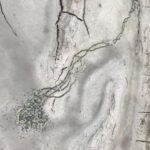

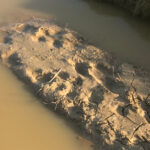
1 Comment
Lawrence Jupp · 3 May 2020 at 12:58
Jolly good. Enjoyed it and learnt quite a lot BUT don’t be American. White Arse not Ass.
Hope all is going well now that you are back at work.
Dad
________________________________